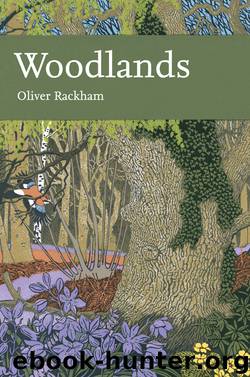Woodlands by Oliver Rackham

Author:Oliver Rackham [Oliver Rackham]
Language: eng
Format: epub
ISBN: 9780007405640
Publisher: HarperCollins Publishers
CHAPTER 13
Wild and Planted Trees
Tree planting is not a gift to nature…[it is] like trying to teach kids about dairy farming by letting them play with milk bottles.
P. Evans, Tree News (1993)
Planting distorts the ecological ‘story’ the [Australian] bushland holds and considerably reduces the value of bushland for ecological research and education on the operation and resources of existing natural systems and their response to disturbance.
L. McLoughlin, 20011
PEOPLE HAVE planted trees in orchards and gardens probably since Neolithic times, and since Roman times have imported fruit trees from Europe. Planting areas of trees for timber or underwood was very rare before the seventeenth century. In the twentieth century, tree-planting took off on a far larger scale (Chapter 18). The Forestry Commission established, or encouraged others to establish, timber plantations, first on heath, moorland and poor agricultural land, and then in the third quarter of the century on the sites of existing woods. Then from 1973 (‘Plant a Tree in ’73’) the conservation movement took up tree-planting on an increasing scale, mainly in non-woodland situations. Between them these people have probably planted more trees in Britain, outside gardens and orchards, than in the whole of history before 1900. Most of the Commission’s trees were exotics such as Sitka spruce and Corsican pine. Most of the conservationists’ were thought to be native.
Motives for planting have been varied and sometimes incompatible. Common to many of the motives are the assumptions (usually unspoken and untested) that existing or past trees were themselves planted, that planting is needed to replace them, and that the trees now being planted will reproduce the properties for which their predecessors were valued. Is this so?
The fashion for transplanting trees from somewhere else (rather than sowing seeds on the site) leads to damaged or altered trees. Digging up a tree leaves much of the roots and mycorrhiza behind; growing a tree in a container constricts the roots. (Does it ever recover a normal root system?) Trees moved to another climate or a new soil may lack the proper mycorrhizal fungi and may be exposed to a world of new and hostile micro-organisms. Transplanted trees often die, and if they survive may suffer more than wild trees from drought or windblow. More surprisingly, some exotic trees, such as sycamore in Britain or Monterey pine (Pinus radiata) in Cornwall or Tasmania, fare better in new environments to which they are not adapted than in their home environments to which they should be adapted.
Download
This site does not store any files on its server. We only index and link to content provided by other sites. Please contact the content providers to delete copyright contents if any and email us, we'll remove relevant links or contents immediately.
Sapiens: A Brief History of Humankind by Yuval Noah Harari(14312)
The Tidewater Tales by John Barth(12625)
Mastermind: How to Think Like Sherlock Holmes by Maria Konnikova(7276)
Do No Harm Stories of Life, Death and Brain Surgery by Henry Marsh(6905)
The Thirst by Nesbo Jo(6877)
Why We Sleep: Unlocking the Power of Sleep and Dreams by Matthew Walker(6651)
Life 3.0: Being Human in the Age of Artificial Intelligence by Tegmark Max(5507)
Sapiens by Yuval Noah Harari(5321)
The Longevity Diet by Valter Longo(5039)
The Body: A Guide for Occupants by Bill Bryson(5027)
The Rules Do Not Apply by Ariel Levy(4907)
The Immortal Life of Henrietta Lacks by Rebecca Skloot(4548)
Animal Frequency by Melissa Alvarez(4424)
Why We Sleep by Matthew Walker(4394)
The Hacking of the American Mind by Robert H. Lustig(4336)
Yoga Anatomy by Kaminoff Leslie(4331)
All Creatures Great and Small by James Herriot(4267)
Double Down (Diary of a Wimpy Kid Book 11) by Jeff Kinney(4240)
Embedded Programming with Modern C++ Cookbook by Igor Viarheichyk(4138)
